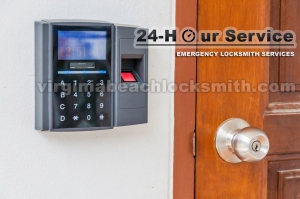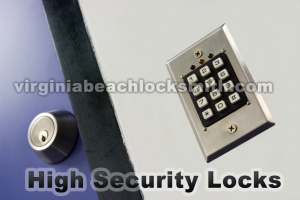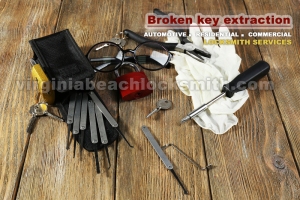If you have a public commercial facility of any sort, then you’re likely already aware that your property is required to have “panic hardware” in order to obey the law, so that you’ll be providing proper egress and ingress in case of an emergency. A panic bar is a push bar that must be installed on every exit door, which permits people to leave quickly. An uninterrupted and unobstructed departure path to a safe place is required also. These doors are usually necessary in schools, malls, restaurants, taverns, and other public spaces. It’s important that you follow the law when it comes to protecting everybody in the building. If you’re not up to code, you will not pass inspection, and you’ll be closed down. When you install these crucial devices, you’ll be safeguarding the wellbeing of every occupant ~ personnel, visitor, and customer alike.
 Most of us cannot concentrate when we find ourselves in a crisis, so it’s vital that you correctly install panic bars throughout your building to avoid any mishaps. Follow all regulations, and maintain these doors routinely. Properly installed and functioning panic hardware will make all the difference in a life-or-death situation.
Most of us cannot concentrate when we find ourselves in a crisis, so it’s vital that you correctly install panic bars throughout your building to avoid any mishaps. Follow all regulations, and maintain these doors routinely. Properly installed and functioning panic hardware will make all the difference in a life-or-death situation.
Panic hardware consists of a latching device, with a crossbar or touchpad spanning at least half of the width of the door, releasing the latch when it’s pushed. Panic hardware is also referred to as an “exit device” or “crash bar”; for fire doors, it’s called “fire exit hardware.” This dedicated hardware is used wherever the current code necessitates that you make it possible for a large number of persons to make a quick exit, and it also provides optimized durability.
The International Fire Code (IFC), the International Building Code (IBC), and the National Fire Protection Association (NFPA) 101 Code are the most common fire safety and building codes in the United States. You’ll have to determine which code, and which edition of that code, applies expressly to your property. Local codes in your area may oblige you to follow additional requirements. Be sure you’re fully compliant.
On the inside, they make a fast exit in an emergency possible. Panic bars will also prevent entry from the opposite side of the door. A panic bar locking from the outside only is allowed on an exit discharge door. In general, rooms with electrical equipment must include panic hardware or fire exit hardware that permits a professional technician to leave if there’s an explosion or fire.
When you install panic hardware on balanced doors, a touchpad-style device is necessary. Code requirements normally prohibit the installation of any other kind of lock on a door with panic hardware, except for electromagnetic locks released by a sensor or switch. The touchpad shouldn’t extend more than halfway across the door. At all times, anyone who needs to get out has to be able to have access to an exit route door that opens from the inside ~ without having to use any tools or keys, and without having to know any specialized information.
Installed on doors that open to the outside, panic bars are available in a big variety of styles. Most are equipped with an alarm ~ stopping anyone exiting from stealing anything or avoiding paying a tab. Constructed vertically or horizontally, all panic bar door openers function the same way: When the bar is pushed, the door opens. The precise number of exit doors required, and the style guidelines you have to follow, will all depend on the size, height, and type of building, as well as its purpose and occupancy level.
The existing requirements apply to doors that either lock or latch. For instance, you don’t need to have panic hardware on a free-swinging door with only a pull handle or push plate. The prevailing code requires panic hardware only for specified occupancy types. A property designated as “assembly occupancy” is typically a space or building where large groups gather, such as a stadium, theater, or gym. An “educational occupancy” is a school building for children up to the last year of high school. Property used as college classrooms is considered “business occupancy”; note that some college classrooms ~ serving as lecture halls, for example ~ are big enough to be classified as assembly occupancy. The NFPA 101 Code includes a distinct occupancy classification for “daycare occupancy,” which is a place used for daycare for kids or adults. Finally, a “high-hazard occupancy” ~ any place containing a high level of hazardous materials ~ is a space at risk for explosions.
A panic bar’s push pad must be at least half the width of the door, so when you install a panic device, follow the template included with the packaging to mark the door for exactly where to place it. The template will show you where to drill the holes and mount the hardware. The center of the panic bar’s push pad should be at a standard height of 41″ from the ground. In schools and daycare facilities, this measure can vary. When you attach the panic bar to the door, use only the screws included in the packaging, so you won’t void the warranty. After installing the panic bar, test the push pad to make sure it’s fully functional.
There are all kinds of panic hardware. Rim devices are easily installed, and call for minimal maintenance. The panic hardware with surface vertical rods is more difficult to install. There’s also a panic bar with a concealed vertical rod, which is more costly as well as significantly harder to install. How do you decide? As we’ve discussed above, choose the panic bar required for each door based on your building’s parameters. In most cases, it’s best to hire an expert.
If your commercial property is anywhere in Virginia Beach, Virginia, find a reputable security professional, such as a commercial locksmith specialist at Virginia Beach Locksmith. Each technician on staff there is exceedingly qualified to help you find the perfect panic bars for all your building’s evacuation doors.
Aricle source here: WHY PANIC BARS ARE ESSENTIAL FOR YOUR COMMERCIAL BUILDING



